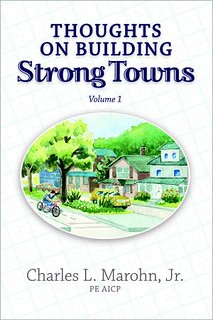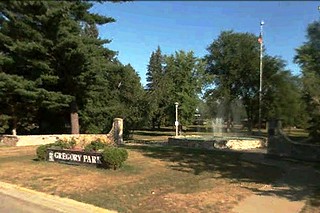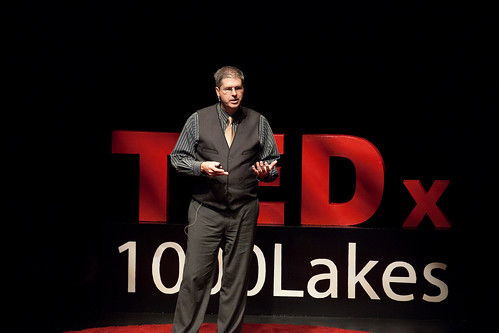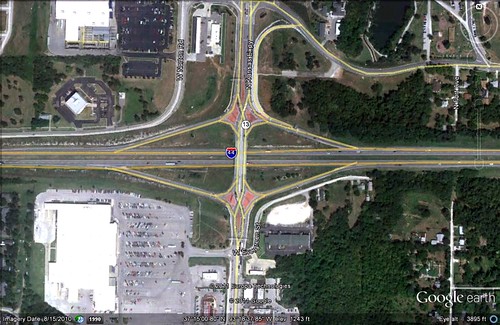A fiscal conservative's manifesto against sprawl

Posted September 18, 2012 at 1:26PM
I don’t know that I was the first national writer to notice Chuck Marohn’s Strong Towns family of web sites and enterprises, including a very good blog. But I know I was early since, in Chuck’s new book, Thoughts on Building Strong Towns (Volume 1), he says he started writing the blog in 2009 and that’s when his work also makes its first appearance in my own writing.
In my 2009 observation, I noted that the environment had been shortchanged by the federal stimulus legislation, in part because of the emphasis on “shovel-ready” construction. In my research on the subject, I had uncovered this bit from Chuck:
“We already have more infrastructure than we can afford to maintain and this imbalance, combined with the massively inefficient development pattern it has induced, is the real drag on the economy. Building even more infrastructure on this same model is simply digging the hole deeper.”
I was intrigued, because this economic argument, while not entirely new, was coming from a new voice, and from someone who had not, as far as I could tell, come up through the usual channels of planning schools and smart growth activism.
Indeed. Charles L. Marohn, Jr., is a small-town Midwesterner who became a civil engineer, didn’t like what he saw, and simply had to start telling people. He’s still a small-town guy, living in Brainerd, Minnesota, a city of about 13,000 whose major attraction may well be its water tower.  But he has become more worldly (I almost typed “wordly,” heh, inviting all sorts of pot/kettle jokes) almost day-by-day in the three years since that first notice.
But he has become more worldly (I almost typed “wordly,” heh, inviting all sorts of pot/kettle jokes) almost day-by-day in the three years since that first notice.
Chuck is now a star among people who think about towns and cities, in great demand as a consultant and speaker, which he clearly enjoys. In my opinion, his emergence as someone worth paying attention to is not just because he is such an earnest, nice guy (although that's part of it), but also because his plain, easy-to-understand logic about public spending and return on investment is so consistent, and insistent. Somewhere along the line he and the Congress for the New Urbanism discovered each other, and that has been to the benefit of both.
Thoughts on Building Strong Towns is dedicated to Chuck’s friends in CNU. But, lest that raise red flags among readers who are skeptical of new urbanists, I should hasten to add that Chuck does not fit the CNU caricature of promoters of more tidy greenfield development or the sorts of design freaks who rail against modernist architecture. No, Chuck is much more concerned with municipal and regional growth patterns, the same part of that school of thought that first caught my own attention.
But, while my concern with sprawling growth patterns was rooted in their effect on the landscape, on the environment, and on severely compromised populations left behind, Chuck is all about the money. As Thoughts on Building Strong Towns makes quite clear, Chuck believes that sprawl is a Ponzi scheme and we the taxpayers are the ones left holding the empty bags.
In fact, the lead chapters of the book are devoted to the Ponzi thesis, whereby municipalities chase outward growth to find new tax revenue that proves insufficient when the infrastructure needs repair; so they chase even more new growth to pay for the previous round, over and over, until the pattern chokes the economic life out of the place. In Chuck’s words:
“The local unit of government benefits from the enhanced revenues associated with new growth. But it also typically assumes the long-term liability for maintaining the new infrastructure. This exchange -- a near-term cash advantage for a long-term financial obligation -- is one element of a Ponzi scheme.
“The other is the realization that the revenue collected does not come near to covering the costs of maintaining the infrastructure. In America, we have a ticking time bomb of unfunded liability for infrastructure maintenance . . .
“We've done this because, as with any Ponzi scheme, new growth provides the illusion of prosperity. In the near term, revenue grows, while the corresponding maintenance obligations -- which are not counted on the public balance sheet -- are a generation away.”
Chuck first explained the phenomenon on the Strong Towns Blog, then elaborated it there, and then again on Grist, and ultimately in a variety of forums of republication. The new book lays it out in great detail. The only way to avoid the consequences, Chuck believes, is to direct growth to places with already-existing infrastructure, and in efficient form.
The book doesn’t get environmental - that’s not Chuck’s thing, professionally - and it doesn’t get political, either. But he can be unsparing in his lacerations of his colleagues in the engineering field. I don’t think Chuck uses the word “ethics” much if at all in his writing, but my sense is that he believes his profession is encouraged to think expansive and dramatic even when the return on investment, if properly accounted, is negative. He begins one essay in the book, titled “The Infrastructure Cult,” by saying a 2011 report by the American Society of Civil Engineers should have its title changed to Pretending it is 1952.
One of Chuck’s more memorable discussions related to engineering concerns something called a “diverging diamond” interchange. A diverging diamond, apparently, is a complicated way to keep vehicle traffic flowing when a major arterial road intersects a freeway and the engineer has a fair amount of land to engineer with. In the case that Chuck highlights, the project included some add-ons that were either an earnest attempt to create some walkability in a place that is ridiculously unwalkable no matter what one does with it, or a pro forma attempt to comply with new engineering standards regardless of context. I featured it on my own blog.
Nonetheless, the engineers involved were proud of their accomplishment and tried to make more of it than, in Chuck’s estimation, it deserved. Big mistake. His words:
“This interchange is not ‘friendly’ to pedestrians or cyclists. Suggestions that red decorative brick or yellow markings on the sidewalks would make it so are absurd.
“If we in the engineering profession can't step back and acknowledge the absurdity of this situation -- the absurdity that mindless adherence to standards has created -- how can we expect to be taken seriously as leaders by a country going through a difficult and painful economic transition?
“It is not good enough to simply follow the ASCE and demand ever more money for our profession when we turn around and waste it in spectacular amounts on things that provide no return (in this instance, moving cars a little faster and building expensive pedestrian/bike facilities that will never be widely used because they are despotic and demeaning). If we want to be part of the solution, we need to reorient ourselves away from our obsession with moving cars more efficiently and towards building places of value.”
I bold that last sentence because that, in essence, is Chuck’s philosophy and that of Thoughts on Building Strong Towns.
There are quite a few essays in the book about mobility and transportation infrastructure, including about the difference between “roads” and “streets” and why Chuck believes the latter have more value. But some of my favorite parts of the book aren’t explicitly concerned with roads or growth patterns but, rather, are more personal. I have a theory that, the closer a writer’s words are to his or her heart, the better the writing will be. One essay is titled “Faith and Community,” in which Chuck, who was raised Roman Catholic, recounts his experience and friendship with a tightly-knit Hasidic Jewish community, as well as his observation of Catholicism in Italy.  In the essay, he reveals that “my Catholic faith went from one of a personal and rather self-serving relationship with God and into one of seeing the teachings of Jesus through the prism of community.” (In this respect I think Chuck might find common ground with Michael Abbaté, author of Gardening Eden, and especially Reverend Tim Keller, of New York City's Redeemer Presbyterian Church.)
In the essay, he reveals that “my Catholic faith went from one of a personal and rather self-serving relationship with God and into one of seeing the teachings of Jesus through the prism of community.” (In this respect I think Chuck might find common ground with Michael Abbaté, author of Gardening Eden, and especially Reverend Tim Keller, of New York City's Redeemer Presbyterian Church.)
Another favorite, and I’ll close with this one, concerns Gregory Park in Chuck’s home town of Brainerd (he also claims nearby Baxter). On the surface it’s about design, as he relates how the park’s components and relationship to its surroundings have good and bad aspects. But his writing - almost a conversation with himself - explaining what the park had meant to him, and what it could mean now, reveals some insight as to why Chuck thinks about community at all. Much of his writing is anchored in Brainerd and Baxter and, when that is the case, it can particularly shine.
Thoughts on Building Strong Towns is not a particularly expensive book. (I bought the Kindle edition.) If you tend to agree with Chuck’s direction, it will strengthen your arguments. If you don’t, or are not sure, it will at least make you think, and it may interest you that it is coming from a fundamentally conservative place. And if, like me, you are already a fan of Chuck’s work, it will bring some of his best writing together for you in one handy place. Recommended.
Related posts:
- Building resilient cities and towns with fiscal conservatism (October 4, 2011)
- How to strengthen a town with prudent investment and common sense (January 25, 2011)
- A recovering engineer posts a photo of "sustainability" (December 9, 2010)
- Chuck's advice: lead with the financial case for smart urbanism (May 28, 2010)
- Small town changes: “I watched the growth – it’s become ‘Paradise Lost’ for me” (March 16, 2010)
- A true conservative takes aim at pretenders who defend sprawl (March 12, 2010)
- New data on the missed opportunity of the stimulus (December 1, 2009)
Move your cursor over the images for credit information.
Please also visit NRDC’s sustainable communities video channels.

